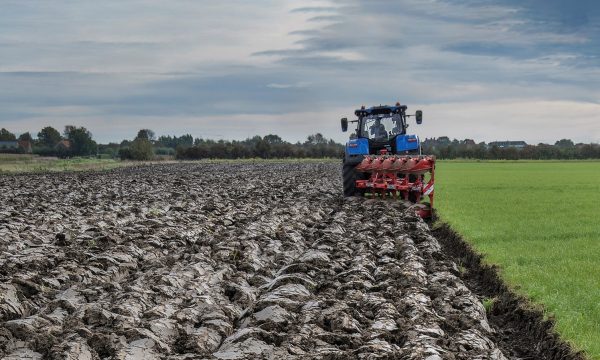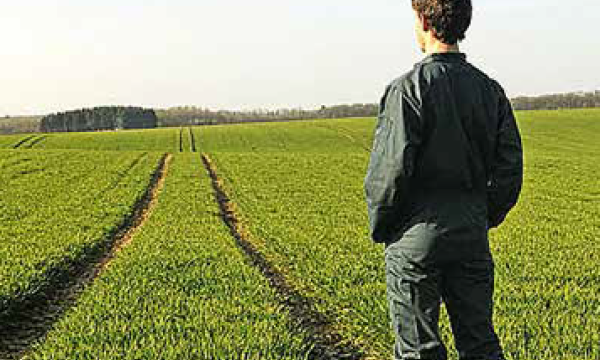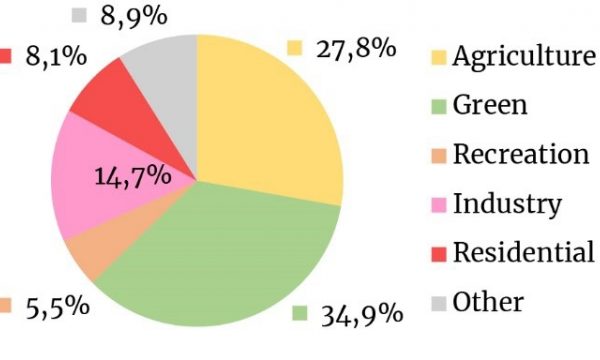Press release Public land ownership in Flanders and Brussels mapped for the first time: Agricultural land policy in function of sustainable agriculture is an opportunity
For one in five of the professional farmers in Flanders and Brussels, at least 10% and on average a quarter of the acreage consists of public land. Total public land ownership in Flanders and Brussels amounts to 214,000 hectares, accounting for 17% of the total plot area. This is according to research by the Institute for Agricultural, Fisheries and Food Research.
Public land is owned by OCMWs, churchwardens, governments or other (semi-) public institutions. Among PCSWs and churchwardens, who mainly own agricultural land, there has been a sharp decline (sale) over the last 20 years. The total amount of land (of all public owners combined) increased by 10% over the same period. Dr. Hans Vandermaelen, ILVO researcher on Public Land: "It is striking that public land in Flanders and Brussels is used for just about all policy purposes, such as nature, water, industry or housing, but rarely for agriculture." This research sheds new light on the debate about the need for an agricultural land policy. The results of this study are in line with an earlier analysis of public lands in East Flanders.Two-thirds of public land ownership is in open space, quarter is farmland
It is the first time that the land ownership of all federal, regional, provincial and local governments, OCMWs, public philosophical institutions such as churchwardens and other (semi-)public organizations and partnerships has been mapped. All together, they have property rights to almost 17% (over 214,000 hectares) of the total plot area in Flanders and Brussels (this does not include public roads, rivers or squares).
Public land ownership in Flanders and Brussels
Source: ILVO based on public data (FOD Financiën, 2024)
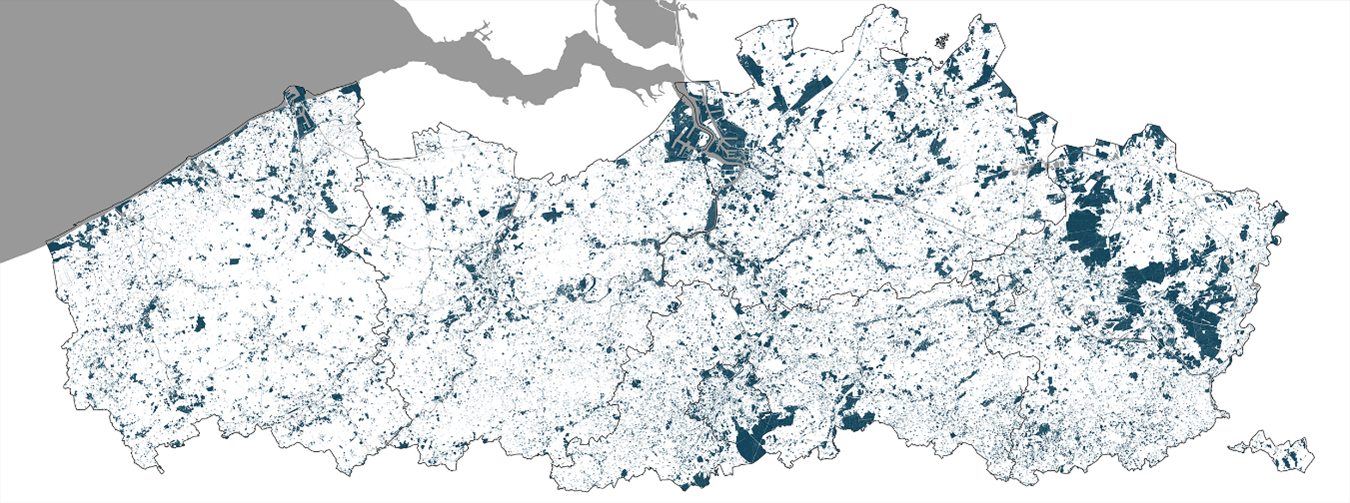
Two-thirds of public lands are in open space zoning (agriculture, nature, parkland). 41% are in green zoning, followed by 25% agricultural zoning. In practice, agricultural activities are recorded on 31% of public land.
Public land ownership in Flanders and Brussels, by institution and by destination
Source: ILVO based on cadastre data (FPS Finance, 2024), space accounting (Department of the Environment, 2024) and Brussels regional zoning plan (perspective.brussels, 2001)
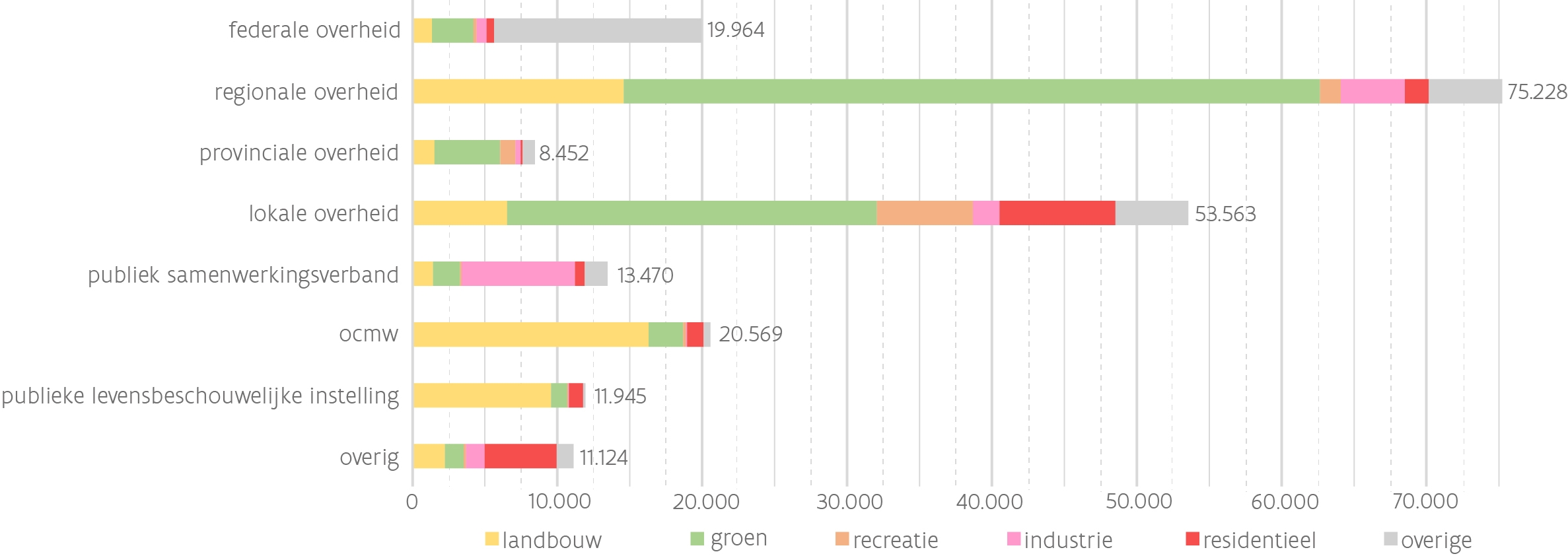
Provincial differences
In terms of order of magnitude of public land ownership, Limburg and Antwerp lead among the Flemish provinces. Limburg has 58,979 ha of public land plots, accounting for over 26% of the total province area. Antwerp has 50,773 ha of public land ownership, accounting for almost 20%. In Brussels, almost half of the plot area is in public ownership, amounting to some 6,095 ha. These are mainly green uses (Bois de la Cambre).
The area of public plots in the provinces of West and East Flanders and Flemish Brabant fluctuates between 30,000 ha and 35,000 ha: West Flanders has 34,254 ha or almost 12% of all plots in the province. East Flanders 33,596 ha or over 12%. Flemish Brabant 31,091 ha or nearly 16%.The share of (public) agricultural land within the total of (provincial) public land is above 10,000 ha in three provinces: In West Flanders it is 12,903 ha (38% of public land in the province). Flemish Brabant has 11,160 ha of public agricultural land (36% of public land in the province). Limburg accounts for 10,945 ha of public agricultural land (19% of the total area of public land in the province).
In East Flanders and Antwerp there are about 9,000 ha of public agricultural land: in East Flanders there are 9,268 ha (28% of public land in province) and in Antwerp 9,141 ha (18%).
Share of public land in relation to parcel area by county 2024
Source: ILVO based on cadastre data (FOD Financiën, 2024)
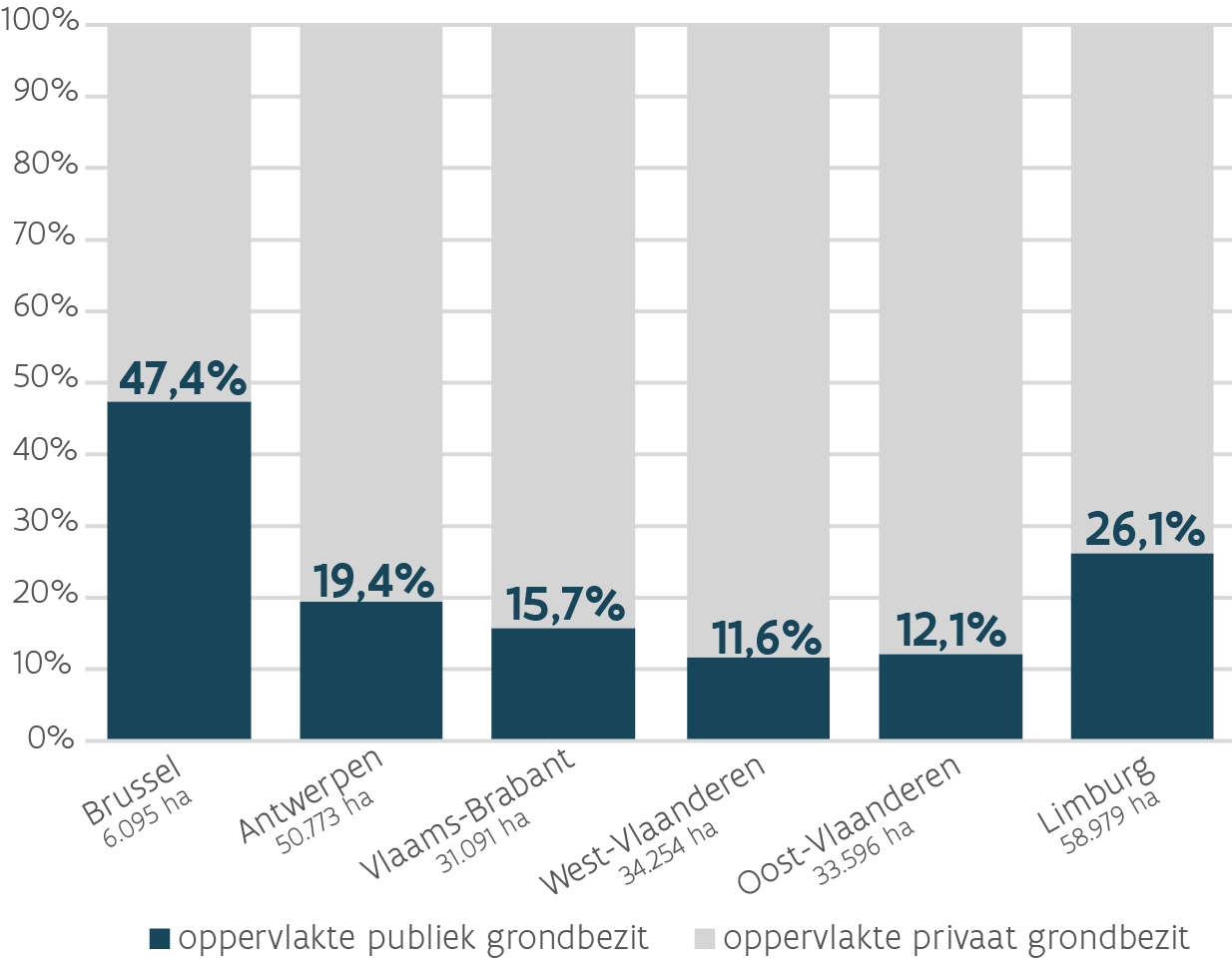
Public land according to use, per province and Brussels
Source: ILVO based on cadastre data (FPS Finance, 2024), space accounting (Department of the Environment, 2024) and Brussels regional zoning plan (perspective.brussels, 2001)
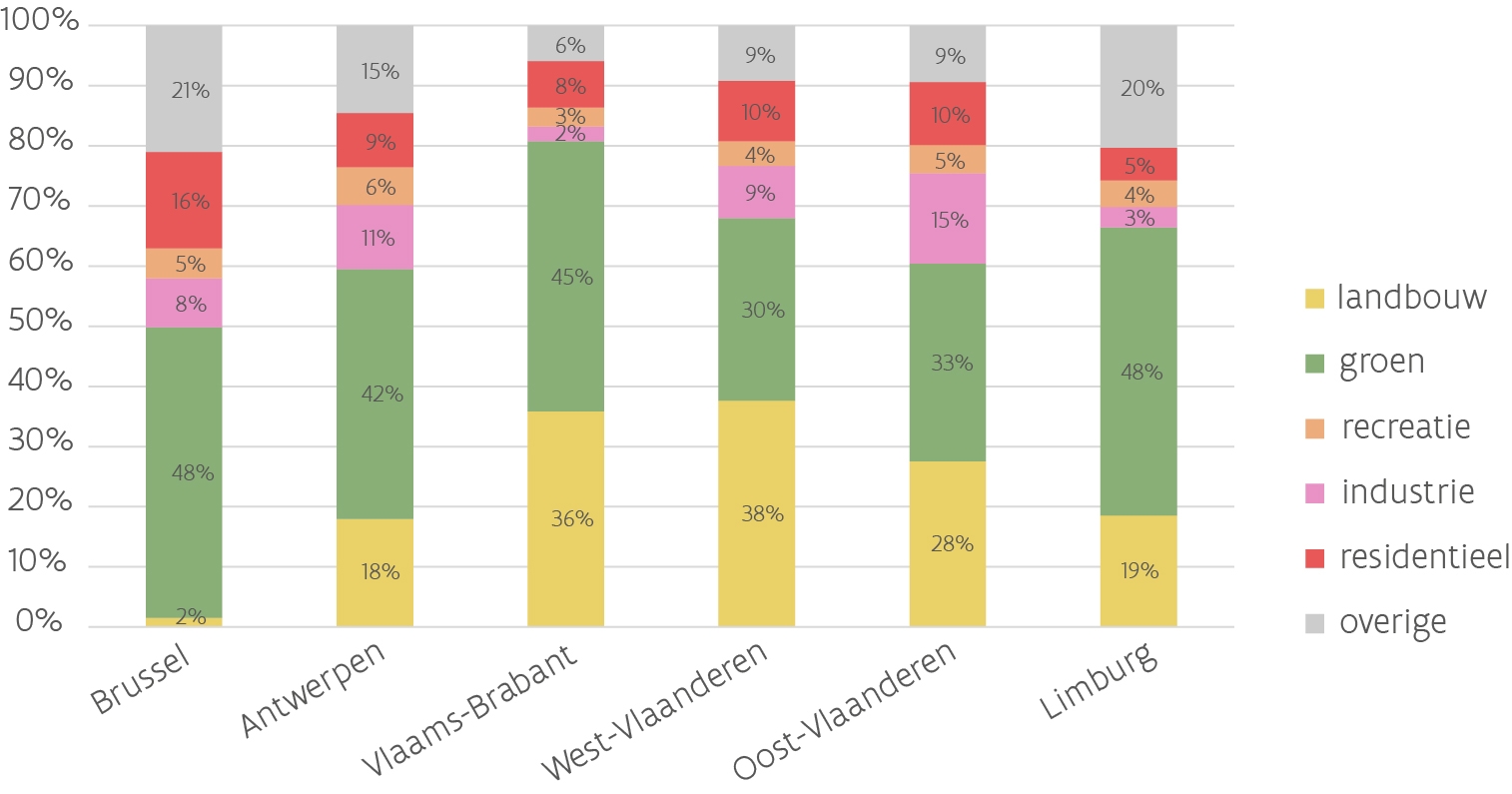
Churchwardens and OCMW's, owners of much agricultural land, are selling off
OCMWs (government social organizations), churchwardens and their predecessors have owned thousands of acres of farmland for many centuries, sometimes even outside their own territory. Recently, they appear to be rapidly reducing their land holdings. Declines of 30% (CPASs) and 10% (churchwardens) are noted in just under 20 years across all land uses.
Land holdings of OCMWs, by size and location
Source: ILVO based on cadastre data (FOD Financiën, 2024)
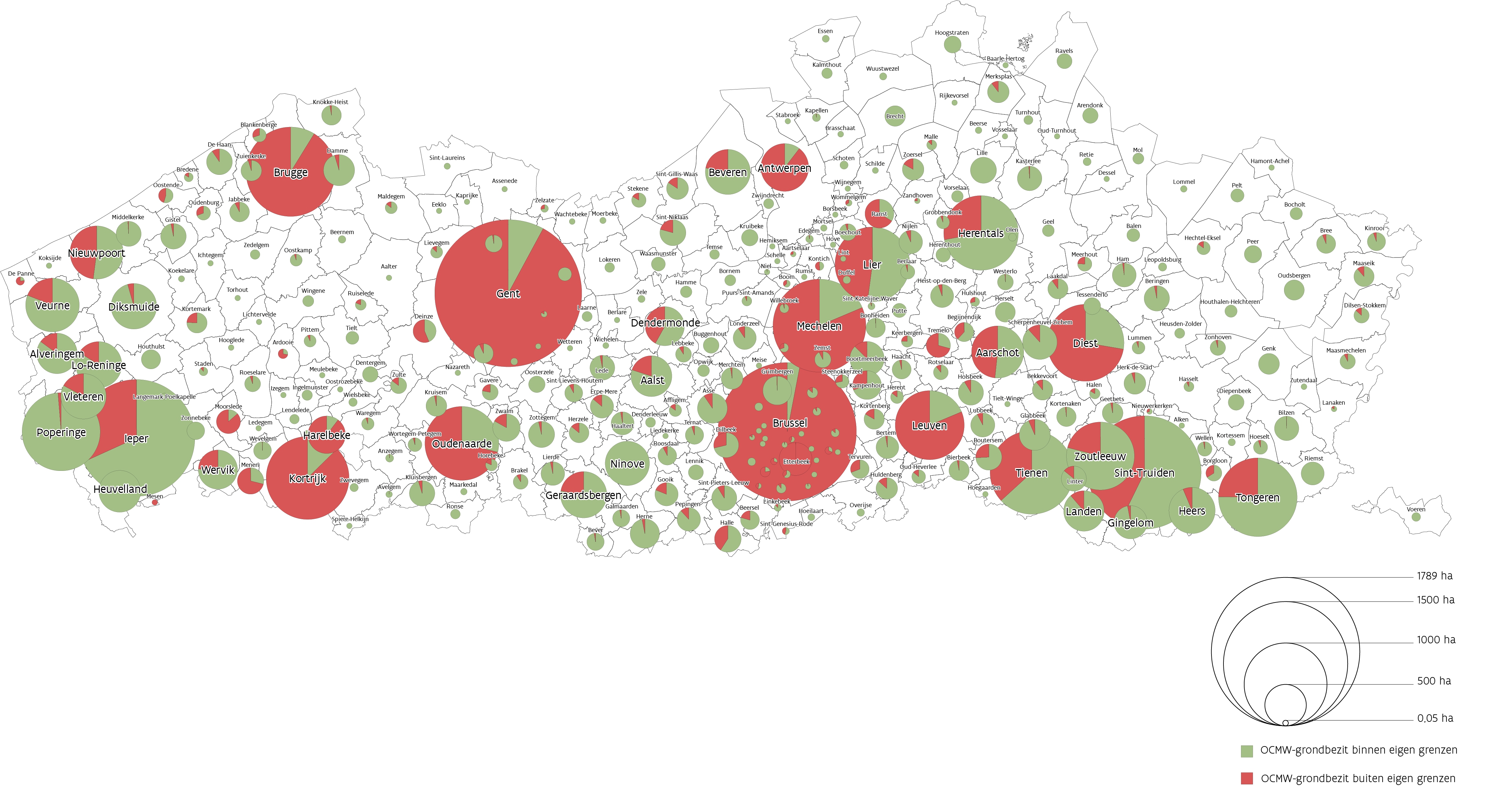

ILVO researcher Glenn Willems: "In general, public institutions have been particularly active in the land market over the past 20 years. This led to a 10% structural increase in public land ownership."
Evolution of land ownership by type of government agency
Source: ILVO based on cadastre data (FPS Finance, 2005-2024)

These lands are used to achieve policy goals around nature, water, mobility, industry, housing and many others. For agriculture, such an active land policy hardly exists, if at all.
Public farmland: scale effect and risk
One in five professional farmers in Flanders and Brussels, 3652 farms in total, appear to operate with more than 10% public land in their acreage. On average, public lands even make up one-fourth of their acreage, with a few outliers up to 100%.
In any case, sales decisions have an effect of scale that sometimes extends far beyond the public lands themselves. "If a farm suddenly loses a quarter of its acreage on sale, this has a potentially negative impact on the entire farm, including the private land in other words," Vandermaelen concludes.
The 3,652 professional farmers for whom more than 10% of their acreage is public land cultivate a total of 45,411 hectares of land belonging to public institutions. If the rest of their acreage is added, the total is 167,678 ha of land, or one quarter (24.9%) of the total agricultural use area (674,817 ha in 2022). Through sales decisions (of the public portion of a farmer's acreage), public institutions can influence a much larger agricultural use area.
"Through their land policies, public institutions thus help determine the future of one-fifth of professional farmers, and of one-quarter of all land worked by professional farmers today in Flanders and Brussels."
This scale effect can work both ways: negative or positive. If governments were to use their public lands strategically, for example, to help make the agricultural sector more sustainable, the effect could also extend favorably to the private lands of tenant farmers.
In practice, the scale effect is even greater when non-professional farmers such as hobby farmers are included.
Eight perspectives for a debate on public (agricultural) land
The new insights from this research provide material for social debate. The figures, revealed dynamics and evolutions show an urgency. ILVO puts forward 8 angles for this debate, which are explained in more detail in an accompanying report.
2. Lots of agricultural land is affected: A quarter of the entire agricultural space may suffer favorable or unfavorable influences as a result of choices made by public landowners.
3. Young transferees and new farmers: In a rapidly aging sector, stable, thoughtful public farmland policies create opportunities for young and new farmers.
4. Term of use: Long-term certainty about the use of public farmland sensitively increases the success rate for forward-looking business strategies or transitions. For example, farmers will more readily invest in soil care if they can reap the benefits themselves later.
5. Policy instrument: In addition to financial and legal incentives, making public farmland available to farmers can make ongoing or new farm sustainability plans more feasible.
6. Social use value vs. market price: In addition to a financial value, public land par excellence can also have another, social use value. For example, soil care, water buffering, landscape care, climate interventions, local food supply, food security, .... Explaining and defining this social use value is necessary to put the financial value and the choice of whether or not to sell public land in a broader perspective. This requires research and social thinking.
7. Privatization difficult to reverse: Private actors who acquire public land do not tend to sell back smoothly. What a public landowner sells, he loses.
8. Need for area-specific coordination: Several public institutions own land outside their own territory. Questions arise about how to use them usefully. More cooperation, consultation and relief for public administrations is necessary to be able to utilize the social use value of these lands.
In the framework of the exhibition "Gentse Gronden" (STAM-ILVO) about the East Flemish figures, there was already a lot of public consultation last year.
Administrator-General Joris Relaes (ILVO): "This dialogue always shows that public land ownership is not a problem, but rather offers opportunities to enter into dialogue with the farmers who farm it.
The exhibition can still be visited until the end of September. More info: https://www.stamgent.be/gentsegronden
